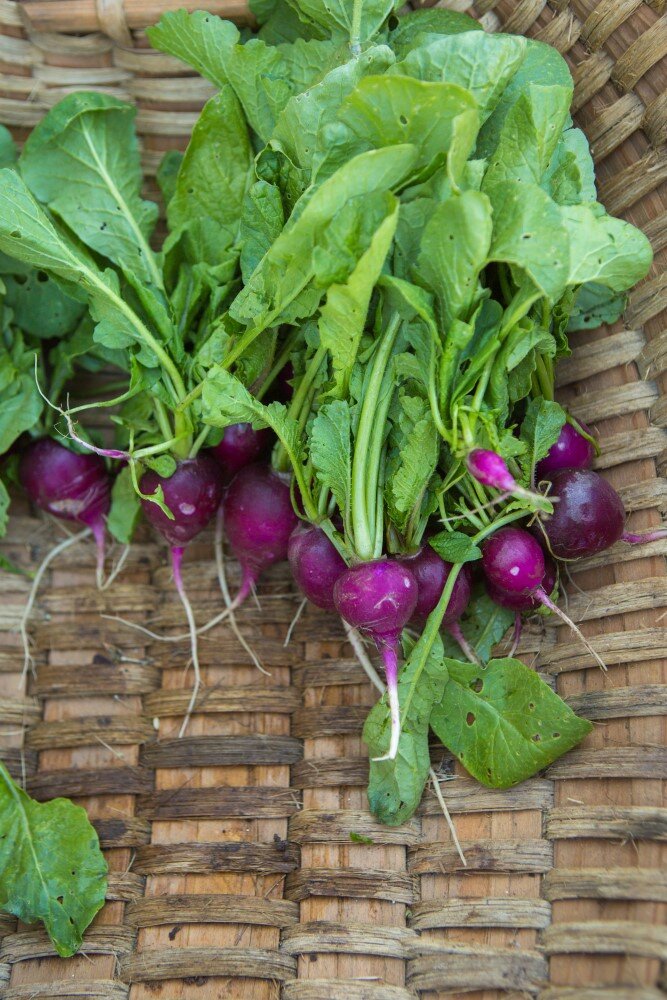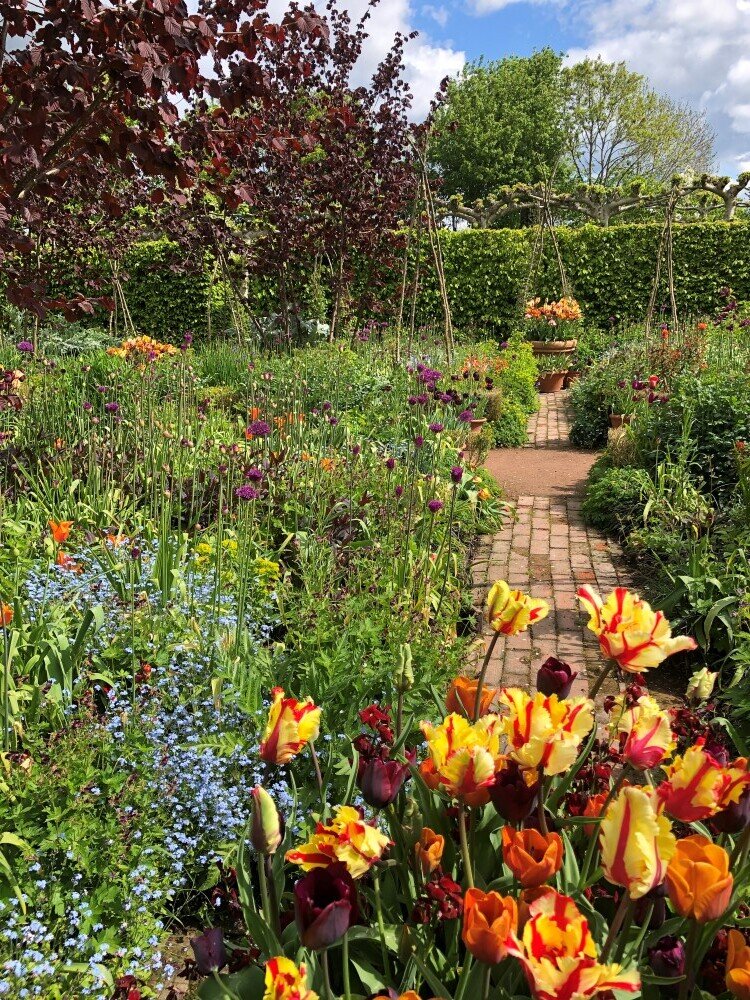May 2021
Our garden in May can be better than anything else that this world has to offer. It is all the things we ever wanted or needed outside our back door, accessible, tangible and giving us so much more than we ever put into it. The tulips are sumptuously sensual and the fruit blossom at its most bountiful. The bluebells in the coppice will be fully on song and cowslips, forget me nots, honesty, wallflowers, camassias, and above all the almost unbearable intensity of the new leaves on all the hedges and most of the trees is breathtaking.
But, once past these wonders, you cannot help but see that the garden with its herbaceous borders, vegetable patch and all the other assorted constructs has not really kicked in.
In fact May is traditionally the leanest of months, the ‘hungry gap’ where winter vegetables and fruit have all finished or been used up and summer produce is yet to arrive. But for a few heady weeks the garden is elevated by morning dew and cow parsley, the crab apple and hawthorn blossom and the dawn chorus into the mirror of the garden of Eden that we all hold within us and aspire to.
May is the harbour at the end of the wide ocean, the view of the mountains from the highest peak of them all. It is the place that all the year heads towards.
Yet as I get older May, like all other time, is ever more fleeting. The May of 60 years ago when the days spread out in every direction, from the first fluting blackbird call at dawn to the waves of wood pigeons in the falling light, have gone and will never return.
But age brings skills to balance these losses. I can now sit on a May evening and let the day fold up around me, slipping into darkness, and that fifteen minutes is enough to ease the longing and feed my soul.
The distillation of May over the years might be rarer and more precious but has lost none of its power.
What to do in the garden this month:
SOW FRENCH BEANS
If your soil has warmed up - and only feeling it with your skin will determine that - then you can safely sow a batch of French beans, both dwarf and climbing. These are tender plants that will be knocked right back by a touch of frost and will survive but not grow if the temperature drops below about 10 degrees and then become fair game for slugs and snails. But by the time they have germinated we will be clear of those cold temperatures in most areas and the young plants can grow strongly.
Sow dwarf beans in rows in well manured soil with each bean spaced 6 inches apart and the rows 12-18 inches apart. For climbing beans sow two seeds at the base of each support and remove the weaker of the two once one is established and growing strongly. Water them well and keep them watered throughout the growing season.
THE CHELSEA CHOP
The Chelsea Chop (so called because it is done any time in the weeks around Chelsea Flower Show which has traditionally, in pre-covid days, been in the 3rd week of May) is a way of extending the flowering season of late-flowering herbaceous perennials such as heleniums, sedums, lysimachia or solidago (Golden Rod). If you have several clumps of these plants then cut one of them about half way up the existing growth. If you have just one big clump then reduce just one third of the plant in this way. The result will be that the pruned section will produce side shoots bearing extra flowers which will bloom a few weeks later than the uncut growth and extend the display into autumn.
CUT BACK ALIUM LEAVES
Unlike most bulbs, the foliage of alliums can be cut back immediately after flowering. In a border this will create space for planting tender annuals such as cosmos, zinnias, tithonia or sunflowers.
LILY BEETLE
Check the leaves of lilies and fritillaries for lily beetle. These have a bright red casing on their upper side but are brown on the underside so although very visible when nibbling the leaves - which they do voraciously - they will drop off if they sense trouble and lie on their backs on the ground so are completely camouflaged. There is no known predator so the only control is to pick them off by hand and dispose of them.
DIVIDE & MOVE GRASSES
Unlike herbaceous perennials, grasses are best divided once they have started to grow vigorously. Lift the clump and divide into fairly substantial sections - they grow slowly so do not cut them up into too small pieces. Replant them at the same level they were in before and water in well. Keep watering them weekly until they are growing strongly.
Some grasses seed themselves freely and form crowded clumps and these can be thinned and moved by lifting entire young plants and repositioning with more space around them.
STAKE AND SUPPORT HERBACEOUS PERENNIALS
Any plant that has been knocked or collapsed never looks the same, however carefully you prop it up so the secret is to support plants before they need supporting. If you place supports in position whilst the plants are still relatively short they will quickly be hidden by the new growth and as a result your borders will not look corseted and constrained. It does not matter what you use - I prefer home made metal supports that are rusted and almost invisible after a day or two but stakes and twine or twiggy prunings all work well.
DIVIDE AQUATIC PLANTS
By the middle of May the water of any pond is likely to be warm enough to plant into and to lift and divide any existing plants as well as plant deep water aquatics like water lilies.
DEADHEAD TULIPS
If you have tulips growing in borders, deadhead them once they are past their best. This will stop the development of seed so that all the energy goes into forming new bulbs for next year’s flowers. The best way to deadhead them is simply to snap off the spent flower with the growing seed pod using your fingers.
Do not cut back the stem or any of the foliage as this will all contribute to the growing bulbs as they slowly die back.
TOMATOES
It is time to plant out tomatoes if you have not already done so, burying them deeply - right up to the bottom leaf as the buried section of stem will develop extra roots.
As the young plants grow they form shoots between the leaves and the stem and these are known as side-shoots. They grow with extra vigour and although they do bear trusses of fruit, they take energy from the plant and reduce the overall harvest as well as making a cordon plant straggly. So they should be removed as they appear.
The best way to do this is in the morning when the plant is turgid, simply breaking them off with finger and thumb. However in the evening they will be limper and may tear the plant so should be cut off with a knife.
PLANTING TENDER ANNUALS
By the middle of May tender annuals like sunflowers, Zinnias, Cosmos or Tobacco plants can be planted out into all but the coldest gardens, especially if you have hardened them off for at least a week. Hardening off is important and will mean much faster growing and longer-lasting flowers - so if you buy any of these annuals from a garden centre over the coming weeks, do not plant them out immediately but put them in a sheltered place for a week to acclimatise to your garden, as they will probably have been kept sheltered for best retail display.
I like to use tender annuals both in containers and borders and in the latter I do not use them as bedding but to enrich the general tapestry of the overall planting. So I place them in groups so they make drifts and clumps rather than straight lines.
Space them about 12 - 18 inches apart in a sunny situation that is sheltered from strong winds and water them in well. As long as the temperature does not drop below 5 degrees they should grow strongly and flower well into autumn.
BRING OUT CITRUS PLANTS
My citrus plants spent the winter in the new greenhouse but at the beginning of May I bring them outside although I still keep some fleece to hand to cover them if the temperature plummets.
This is also a good time to prune them, cutting back any damaged, straggly or untidy branches. Oranges and lemons are very forgiving of hard pruning and need reinvigorating so I look to remove a few of the oldest stems every year that can be replaced by new.
PRUNE EARLY FLOWERING CLEMATIS
The best time to prune early-flowering clematis such as c. montana, armandii, alpina and macropetala, is immediately after they finish flowering. Obviously the timing of this will vary considerably in different parts of the country but the principal remains constant and for many of us this occurs at the end of May.
Next year’s flowers are formed on all the new growth made from this period until late summer so if you prune them much later than mid to late June you will be removing potential flowers that would bloom next spring.
Pruning of these clematis is solely to maintain their size and spread for your convenience rather than for any horticultural benefit. So cut back freely, not worrying about individual stems or the position of the cut. Then when you have finished, weed round the plant, water it well and mulch generously with garden compost or bark chippings.
MAKE COMPOST
Compost is the alchemy of a garden, turning waste into black gold and we should compost every scrap of garden and kitchen waste. The secret of making it reasonably quickly is to have a good mix of matter high in nitrogen (green) like grass clippings and drier material (brown) that is high in carbon and then to aerate it often by turning it. This does not have to be a major operation - just forking through it will help a lot. The point is to get oxygen into the heap which in turn feeds the bacteria that eat the decomposing material and convert it into compost which will then enrich your soil with essential bacteria, fungi and nutrients better than any product known to man.

































